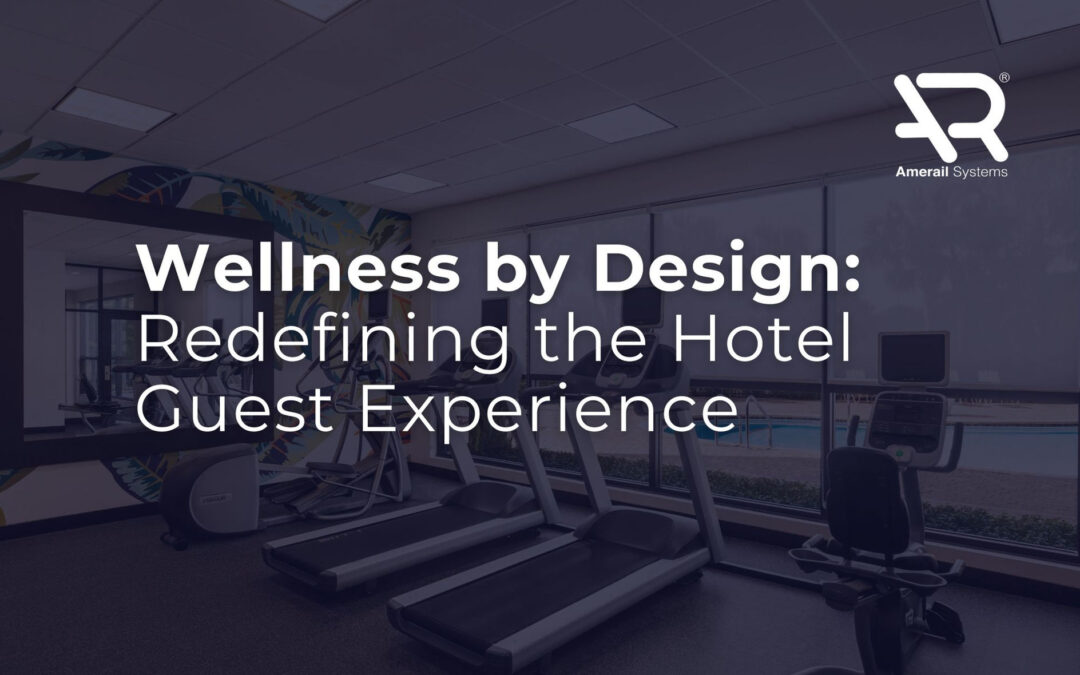This month, our team had the pleasure of attending the HD Expo in Las Vegas, NV. Whether exploring exhibits, making new connections, or hearing from industry leaders, one thing quickly became clear to our team. Wellness in hospitality is no longer a luxury — it’s an expectation.
Today, the wellness industry is not just alive and well, it’s thriving. In fact, calling it merely “thriving” might be an understatement. In 2023 the global revenue generated from the wellness industry reached a staggering $6.3 trillion — and it doesn’t stop there. The industry is expected to reach $9 trillion in global revenue just within the next three years (Hospitality Design). Since wellness in hospitality can encompass everything from fitness centers to luxury spa treatments it can be hard for hotel owners to know where to begin. Given this diversity, how can hotels thoughtfully weave wellness design into the guest experience in ways that are both practical and impactful?
Hospitality Without Compromise
- Too often, travel and compromise are seen as going hand in hand—but that shouldn’t be the case. Hotel guests are already stepping away from their daily routines, so offering a sense of familiarity can provide noticeable comfort. Whether it’s keeping up with a workout schedule, maintaining a nourishing diet, or getting enough restful sleep, having a “piece of home” can make all the difference.
- As travelers seek to maintain their wellness centered lifestyles while on the move, new trends are emerging in the hospitality industry. The rise in blesiure travel highlights the importance of integrating wellness into design. Bleisure in hospitality design enhances guest wellness by creating a physical separation of the space which helps foster a mental separation as well. For example, our recent renovation of the Hampton Inn in Boise, ID, included adding a partition to the guestrooms to help guests clearly separate work from rest.
Wellness Design in Motion
- With wellness on the rise, it’s no surprise that fitness is following closely behind. Hotel owners are noticing an increased demand for wellness amenities such as pools and fitness centers. Along with this, they’re also observing shifts in fitness trends. Previously, hotel fitness centers mainly focused on machines like treadmills, ellipticals, and stationary bikes. As we move further into 2025, hoteliers are noticing a shift in demand. Guests now want a more adaptable space equipped with free weights, yoga mats, exercise bands, etc. This equipment creates a versatile space where guests can complete their personalized workout routines away from home. While treadmills and bikes remain popular, they may no longer be sufficient on their own.
- We’ve even seen some hotels take it a step further and expand their wellness initiatives beyond the hotel walls or even the hotel property. Introducing interest-based activities such as running clubs or adult swim hours not only promotes physical wellness but also fosters a sense of community. These structured group activities create natural opportunities for social interaction, allowing participants to build relationships, share goals, and support one another in a relaxed, engaging environment. These activities also offer a strategic approach to optimizing limited hotel space, transforming it into an opportunity to elevate guest satisfaction and foster deeper engagement.
Broadening the Spa Concept
- The term “spa” can sometimes feel intimidating for hotel owners, often conjuring images of expensive treatments, hot stone massages, and mud baths. In reality, the term “spa” encompasses much more, offering a range of experiences focused on relaxation and wellness. Hot tubs, pools, and saunas all fall under the broader concept of a spa, emphasizing that it’s less about luxury and more about cultivating a sense of tranquility and well-being for your hotel guests.
- Hotels that offer spa services reinforce the idea that wellness isn’t just about feeling your best, it’s also about looking your best. However, even if providing full spa services isn’t feasible, you can still enhance guests’ wellness by adding thoughtful comforts and conveniences within their rooms and bathrooms. Bright lighting, full-length mirrors, quality body care products, bathroom hairdryers, plush mattresses, and temperature control all contribute to a more relaxing stay, helping guests both look and feel their best.
The Power of Biophilic Design in Hospitality
- Wellness isn’t just about what hotel guests do, it’s also about what they experience through their senses. Incorporating biophilic design offers a powerful way to engage the senses and enhance overall well-being. The use of natural elements such as wood, stone, neutral color palettes, soft textures, water features, and fish tanks helps set a calming mood for the guest experience. Using natural elements or design details inspired by the hotel’s geographical region enhances the overall atmosphere, creating a more immersive environment. This can be as simple as featuring artwork that reflects the region where the hotel is located.
- In hospitality, biophilic design isn’t just about bringing the outdoors inside, it’s also about creating spaces that highlight and celebrate the natural views. Gardens and thoughtful landscaping welcome hotel guests even before they reach the doors. Balconies and large windows invite guests to take in stunning views and fresh air, all while preserving their privacy. When wellness is at the heart of your hotel design, guests begin to unwind long before they step through the door.
Meeting Diverse Dietary Needs
- Vegan, vegetarian, pescatarian, gluten-free, keto, dairy-free—the list of dietary preferences and restrictions keeps growing, and accommodating them all can feel challenging. More than ever, today’s hotel guests know they shouldn’t have to compromise on something as important as their diet. Offering healthier and more inclusive dining options plays a key role in supporting overall wellness. Kitchen renovations can improve efficiency, while adding kitchenettes and mini-fridges gives guests greater control over their dietary choices and enhances comfort.
Conclusion
In the hospitality industry, wellness is no longer a luxury, it’s an expectation that defines the guest experience from start to finish. The rise of extended stay hotels shows that guests want a “home away from home.” By thoughtfully integrating wellness into design, amenities, dining, and community engagement, hotels can create environments that nurture mental and physical wellness. Whether it’s through adaptable fitness spaces, inclusive dining options, biophilic design, or added conveniences, wellness has become a cornerstone of hospitality.
Works Cited:
“What’s Next for Wellness in Hospitality?” Hospitality Design, 2024,
https://hdexpo.hospitalitydesign.com/blog/explore-the-floor/whats-next-for-wellness-in-hospitality/.


